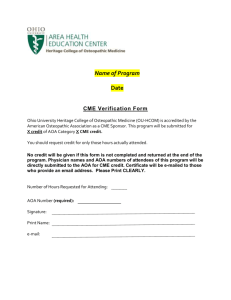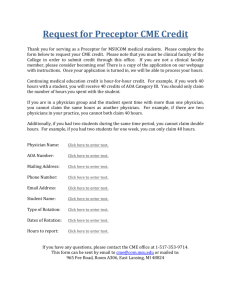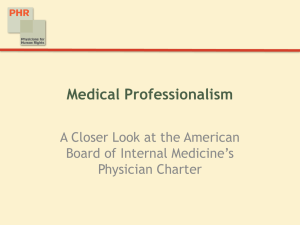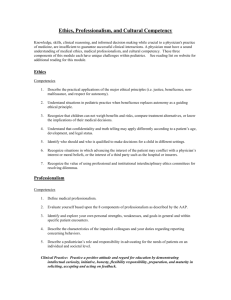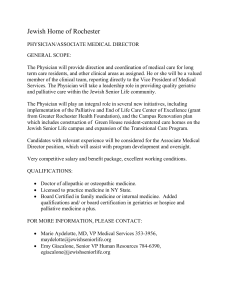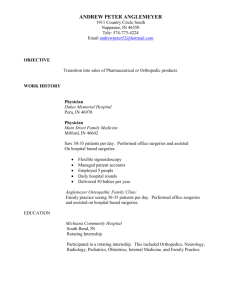medical ethics
advertisement
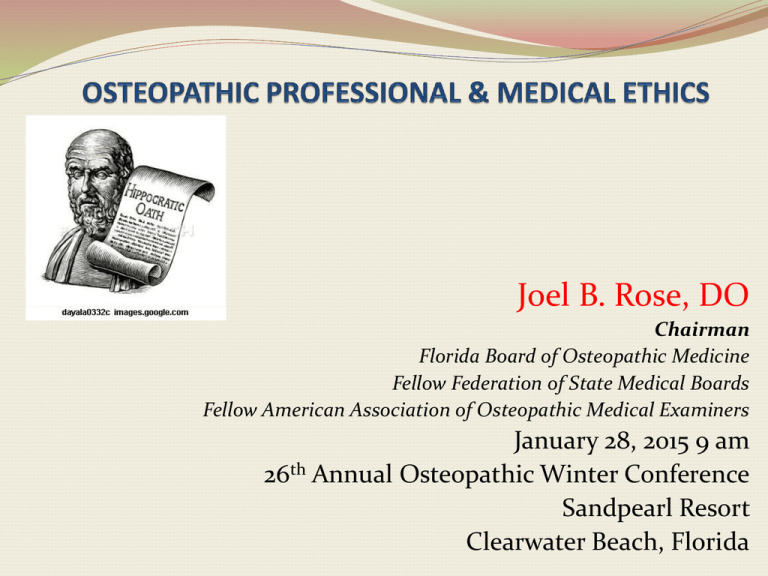
Joel B. Rose, DO Chairman Florida Board of Osteopathic Medicine Fellow Federation of State Medical Boards Fellow American Association of Osteopathic Medical Examiners January 28, 2015 9 am 26th Annual Osteopathic Winter Conference Sandpearl Resort Clearwater Beach, Florida Disclosure I have no financial relationship in regard to the content of this presentation Objectives Fulfill the requirements of the Florida Mandatory CME course on professional medical ethics. Address current ethical issues regarding medical ethics in Florida. Review the AOA Code of Ethics and demonstrate how the principles are codified in Florida Law and Rule. OSTEOPATHIC PLEDGE OF COMMITMENT I pledge to: Provide compassionate, quality care to my patients; Partner with them to promote health; Display integrity and professionalism throughout my career; Advance the philosophy, practice and science of osteopathic medicine; Continue life-long learning; Support my profession with loyalty in action, word and deed; and Live each day as an example of what an osteopathic physician should be. OSTEOPATHIC MEDICAL PROFESSIONALISM 25 States and jurisdictions that have enacted laws permitting medical marijuana use Alaska Illinois New Jersey Arizona Maine New Mexico California Maryland New York Colorado* Massachusetts Oregon Connecticut Michigan Rhode Island Delaware Minnesota Vermont District of Columbia Montana Washington* Florida Nevada * Permits recreational use Hawaii New Hampshire ADP 9/15/14 Marijuana Laws: FAQs from Small Businesses OSTEOPATHIC MEDICAL PROFESSIONALISM How many will order low dose THC for patients? How many of you would consider being the medical director of a cannabis farm? Is it unethical to withhold “ordering” low dose THC in Florida for someone with recalcitrant seizures? Is it unethical to “order” low dose THC for patients? Is it unethical to “order” medical marijuana if amendment 2 passes? OSTEOPATHIC MEDICAL PROFESSIONALISM Does federal law permit the use of medical or recreational marijuana? Under federal law, marijuana remains a controlled substance and therefore both medical and recreational use of marijuana is prohibited This is especially important for business that have federal contracts, received federal grants, or are subject to industry specific rules that have drug-free workplace requirements OSTEOPATHIC MEDICAL PROFESSIONALISM Can a company refuse to hire individuals who test positive for marijuana during pre-employment drug testing? Currently, Arizona, Connecticut, Delaware, Illinois, Maine, Minnesota, and Rhode Island expressly prohibit employers from making employment decisions solely on the basis of a person’s status as a medical marijuana user. In these states the employer may be required to: Give the individual the opportunity to produce proof that the positive result was due to medicinal use Make an individualized assessment as to whether the medicinal use of marijuana would interfere with the candidates essential job duties and responsibilities OSTEOPATHIC MEDICAL PROFESSIONALISM In other states with medicinal or recreational marijuana laws, employer’s are cautioned not to implement a blanket policy of rejecting all candidates who test positive for marijuana Employers are urged to work closely with legal counsel to determine their rights and responsibilities when a prospective employee tests positive for marijuana OSTEOPATHIC MEDICAL PROFESSIONALISM Does a company have to provide reasonable accommodations to users of medical marijuana under the ADA? Employers are not required to provide reasonable accommodations for medical marijuana use because it is an illegal drug under federal law However, employers should remember that in many cases the underlying condition that necessitates the use of medical marijuana may trigger the need to accommodate the employee in another way under ADA OSTEOPATHIC MEDICAL PROFESSIONALISM Conclusion: Employers should keep in mind that many of these state marijuana laws have not yet been tested in court Employers should continue to monitor for developments in the area, draft and enforce policies in accordance with federal and state law, and consult legal counsel as needed Professional Ethics On the horizon Florida Marijuana compassionate use law Amendment 2 – failed but will be resurrected California – Prop 46 - failed Rollback MICRA Mandatory PDMP check Doctor Drug Testing Issues Medical directors Misrepresentation of credentials Which occupations contribute the most to society’s well being? Pew Research Center survey March 21-April 8, 2013 Responses of those who did not give an answer are not shown A lot Some Not Very Much/Nothing 78 Military 15 72 Teachers 18 Medical Doctors 66 Scientists 65 23 Engineers 63 28 Artists 30 Journalists 28 Bussiness Execs Lawyers 8 8 36 7 18 42 24 42 24 18 9 24 37 Clergy 5 42 43 27 28 34 Professional Ethics 86 year old former Ohio state lawmaker and pilot was selling airplane rides at an airport he owned 30 minutes after takeoff the plane crashed killing all six people aboard NTSB reported the pilot failed to maintain control of the airplane which then stalled and he used poor judgment in continuing to fly while legally blind He suffered from macular degeneration FAA medical examiner who was an Ohio ER doctor “failed to assess and report” the failing eyesight OSTEOPATHIC MEDICAL PROFESSIONALISM Professionalism is a core competency expected of all physicians JAOA June 2013 Vol 113 No 6 OSTEOPATHIC MEDICAL PROFESSIONALISM Recognized elements of ethics and professionalism First, do no harm (Non-maleficence) Act as a professional role model (Students, Residents, Fellows) Display respect in interactions with others (Collegiality) Legal & ethical behavior Appropriate management of conflicts of interest Act in the best interest of the patient (Beneficence) JAOA June 2013 Vol 113 No 6 OSTEOPATHIC MEDICAL PROFESSIONALISM AOA’s Code of Ethics offers rules to guide physicians Any assessment of a physicians conduct must be made with due to consideration to the facts & circumstances that existed at the time of the conduct in question Recognizes that a physician may have had to act based upon uncertain or incomplete information JAOA June 2013 Vol 113 No 6 OSTEOPATHIC MEDICAL PROFESSIONALISM Rules & Guidelines Not intended to be a basis for civil liability Perceived failure to comply with an obligation or prohibition is a basis for invoking the AOA’s disciplinary process (Bureau of Membership’s Subcommittee on Ethics) JAOA June 2013 Vol 113 No 6 OSTEOPATHIC MEDICAL PROFESSIONALISM Conduct Physicians conduct shall be consistent with requirements of the law in Providing medical/professional services or Conducting business and personal affairs Status Physicians should use their status as professionals only for legitimate purposes Not used to take advantage of economic or social opportunities or to harass or intimidate others JAOA June 2013 Vol 113 No 6 OSTEOPATHIC MEDICAL PROFESSIONALISM Respect Physicians should conduct themselves with appropriate respect for their patients’ social and culture needs and provide necessary care without regard to Gender Race Color Religion Creed Veteran Status Sexual Orientation JAOA June 2013 Vol 113 No 6 Age Marital Status National Origin Political Belief Mental/Physical Disability Gender Identity OSTEOPATHIC MEDICAL PROFESSIONALISM Compliance is primarily voluntary Make efforts to secure observance by others through formal or informal peer opinion, or when necessary invocation of disciplinary proceedings Adverse events and medical errors should be fully disclosed within the context of appropriate peer review JAOA June 2013 Vol 113 No 6 456.075 Duty to Notify Patients Every licensed health care practitioner shall inform each patient, or an individual pursuant to §765.401(1), in person about adverse incidents that result in serious harm to the patient Does not constitute acknowledgement of admission of liability, nor can such notifications be introduced into evidence AOA Code of Ethics Section 1 (Confidentiality – Protected Information) The physician shall keep in confidence whatever she/he may learn about a patient in the discharge of professional duties The physician shall divulge information only when required by law or when authorized by the patient HIPAA codifies this into law Violations may lead to civil and administrative action Dr A & B Dr. A invites Dr. B to create a concierge practice Practice is extremely successful and Dr. A becomes unable to work Dr. B does all the work of two practices Dr. A returns but needs Dr. B to sign papers for PRN stating he will manage him medically if needed so he can RTW Dr. A locks Dr. B out of the practice Dr. B sues Dr. A Dr. B’s attorney discloses in court filings details of Dr. A’s health issues Is this now a problem for Dr B? Dr A & B Dr. A files a complaint against Dr. B alleging HIPAA violation and improper discharge AOA Code of Ethics Lessons Learned: Violations may lead to civil and administrative action It is not advisable to become a monitoring or treating physician for another physician in your practice Make a medical record of any “courtesy” prescriptions issued Confidentiality must be maintained for medical records especially for super confidential or very sensitive information regarding ALL PATIENTS regardless of how untenable a business relationship may become if you choose to treat a business partner AOA Code of Ethics Lessons Learned: Know the full implications of what you are agreeing to do by contacting the issuing source of the document directly Make sure you have co-counsel well experienced in medical administrative laws (state and federal) in partnership pleadings If terminating a professional relationship give proper and timely notice AOA Code of Ethics Section 2 (Patient Condition) The physician shall give a candid account of the patient's condition to the patient or to those responsible for the patient's care AOA Code of Ethics Section 3 (Physician-Patient Relationships) A physician-patient relationship must be founded on mutual trust, cooperation, and respect Freedom to choose: The patient must have complete freedom to choose her/his physician The physician must have complete freedom to choose patients whom she/he will serve The physician should not refuse to accept patients because of the patient's race, creed, color, sex, national origin or handicap In emergencies a physician should make her/his services available AOA Code of Ethics Section 4 (Abandonment) A physician is never justified in abandoning a patient The physician shall give due notice to a patient or to those responsible for the patient's care when she/he withdraws from the case so that another physician may be engaged 459.015(1)(k) Improper Refusal to Provide Health Care FIRST OFFENSE MINIMUM Reprimand and $5,000 fine MAXIMUM Probation and $5,000 fine SECOND OFFENSE MINIMUM Suspension to be followed by probation and $7,500 fine MAXIMUM Revocation and $10,000 fine AOA Code of Ethics Section 5 (Standard of Care) A physician shall practice in accordance with the body of systematized and scientific knowledge related to the healing arts A physician shall maintain competence in such systematized and scientific knowledge through study and clinical applications (OCC & MOC can demonstrate this) MOL? 456.50 (1)(g) & 459.015(1)(x) Failure to Practice Medicine in Accordance with appropriate level of care, skill, & treatment recognized in general law related to medical practice FIRST OFFENSE: MINIMUM Letter of concern up to 1 year probation and a $1000 fine SECOND OFFENSE: MINIMUM 2 years probation and a $7,500 fine First MAXIMUM Denial and revocation and up to a $10,000 fine MAXIMUM Denial or revocation and a $10,000 fine 459.015(x) Grounds for Disciplinary Action (x) 2. Committing gross medical malpractice (x) 3. Committing repeated medical malpractice as defined in s. 456.50. A person found by the board to have committed repeated medical malpractice based on s. 456.50 may not be licensed or continue to be licensed by this state to provide health care services as a medical doctor in this state. The Boards legal standard is clear and convincing AOA Code of Ethics Section 6 (Self-Regulation) The osteopathic medical profession has an obligation to society to maintain its high standards and, therefore, to continuously regulate itself A substantial part of such regulation is due to the efforts and influence of the recognized local, state and national associations representing the osteopathic medical profession A physician should maintain membership in and actively support such associations and abide by their rules and regulations AOA Code of Ethics Section 7 (Advertising) Under the law a physician may advertise, but no physician shall advertise or solicit patients directly or indirectly through the use of matters or activities, which are false or misleading 459.015(1)(d) FALSE, DECEPTIVE OR MILSEADING ADVERTISING FIRST OFFENSE: MINIMUM Letter of concern SECOND OFFENSE: MINIMUM MAXIMUM Probation and a $5,000 fine Probation and a $1,000 fine THIRD OFFENSE: MINIMUM MAXIMUM Reprimand and a $1,000 fine 3 month suspension to be followed by probation and $5,000 fine MAXIMUM 1 year suspension to be followed by probation and $5,000 fine AOA Interprets the Code of Ethics Interpretation of Section 7 The public should be protected from subjective advertising material designed to solicit patients, which is essentially misleading. Includes: Attempts to obtain patients by influence or persuasion, Employing statements that are self-laudatory and deceptive; (the result of which is likely to lead a patient to a misinformed choice and unjustified expectations. AOA Code of Ethics Section 8 Use of degrees A physician shall not hold forth or indicate possession of any degree recognized as the basis for licensure to practice the healing arts unless he is actually licensed on the basis of that degree in the state in which she/he practices (John Doe, DO, MD) A physician shall designate her/his osteopathic school of practice in all professional uses of her/his name Indications of specialty practice, membership in professional societies, and related matters shall be governed by rules promulgated by the American Osteopathic Association AOA Interprets the Code of Ethics Guide to Section 8 – continued In telephone directory listings of doctors, it is recommended that the doctor's name be followed by the abbreviation DO The abbreviation "Dr" is not recommended because it is misleading. "Dr" can refer to dentists, doctors of medicine, etc. "Phys" is also misleading because it can refer to MDs 64B15-14.001 ADVERTISINGS Any advertisement or advertising is false, deceptive, or misleading if it States or implies that an osteopathic physician has been certified as a specialist in any aspect of the practice of osteopathic medicine unless he or she has in fact received such certification States or implies that the osteopathic physician is a specialist in any aspect of the practice of osteopathic medicine unless he has in fact completed post-doctoral training in the recognized specialty field including internship, residency, fellowship, or alternative training requirements accredited by either the AOA or ACGME for the number of years contemplated for completion of the specialty program 64B15-14.001 ADVERTISINGS However, a physician may indicate the services offered and may state that the practice is limited to one or more types of services when this is, in fact, the case; or States or implies that an osteopathic physician has been certified as a specialist in any aspect of the practice of osteopathic medicine unless he or she has in fact received such certification, meets the training requirements of paragraph above and includes the name of the certifying agency in any statement or advertisement claiming certification, and the certifying agency meets the following criteria: AOA, ABMS, AAPS, ABIPP 459.015(1)(nn) Falsely advertising or holding oneself out as a board certified specialist FIRST OFFENSE MINIMUM Reprimand and $5,000 fine MAXIMUM Probation and $5,000 fine SECOND OFFENSE MINIMUM Suspension to be followed by probation and $7,5000 fine MAXIMUM Revocation and $10,000 fine 456.072(1)(a) & (m) & 459.015(1)(m) Deceptive, untrue or fraudulent misrepresentations FIRST OFFENSE MINIMUM Reprimand and $10,000 fine MAXIMUM Denial of licensure or suspension to be followed by probation and $10,000 fine SECOND OFFENSE MINIMUM Denial of licensure or suspension to be followed by probation and $10,000 fine MAXIMUM Denial of licensure or revocation and $10,000 fine AOA Code of Ethics Section 9 A physician should not hesitate to seek consultation whenever she/he believes it advisable for the care of the patient 456.072(1)(o) & 459.015(1)(z) Practicing Beyond One’s Scope FIRST OFFENSE MINIMUM Denial or reprimand and a $5,000 fine MAXIMUM Denial or suspension to be followed by probation and $5,000 fine SECOND OFFENSE MINIMUM Denial or suspension to be followed by probation and $7,5000 fine MAXIMUM Denial or revocation and a $10,000 fine AOA Code of Ethics Section 10 In any dispute between or among physicians involving ethical or organizational matters, the matter in controversy should first be referred to the appropriate arbitrating bodies of the profession AOA Code of Ethics Section 11 In any dispute between or among physicians regarding the diagnosis and treatment of a patient, the attending physician has the responsibility for final decisions, consistent with any applicable osteopathic hospital rules or regulations AOA Code of Ethics Section 12 Any fee charged by a physician shall compensate the physician for services actually rendered There shall be no division of professional fees for referrals of patients 459.015 GROUNDS FOR DISCIPLINARY ACTION (1) Paying or receiving any commission, bonus, kickback, or rebate, or engaging in any split-fee arrangement in any form whatsoever with a physician, organization, agency, person, partnership, firm, corporation or other business entity for patients referred to providers of health care goods and services, including, but not limited to, hospitals, nursing homes, clinical laboratories, ambulatory surgical centers or pharmacies 459.015(1)(j) KICKBACKS AND UNAUTHORIZED FEE ARRANGEMENTS FIRST OFFENSE MINIMUM Probation and $2,500 fine MAXIMUM Denial or suspension to be followed by probation and $5,000 fine SECOND OFFENSE MINIMUM Denial or suspension to be followed by probation and $10,000 fine MAXIMUM Denial or revocation and a $10,000 fine AOA Code of Conduct Section 13 A physician shall respect the law. When necessary a physician shall attempt to help to formulate the law by all proper means in order to improve patient care and public health FOMA legislative committee Key Contact Physician Advocacy Program Providing expert testimony to the Legislature Testifying at Rules Workshops Serving on State Boards and Committees 456.072(1)(k) & 459.015(1)(g) Failure to perform legal duty or obligation FIRST OFFENSE MINIMUM Reprimand and $1,000 fine MAXIMUM Denial with the ability to reapply after no less than 2 years or revocation and $5,000 fine SECOND OFFENSE MINIMUM Probation and $5,000 fine MAXIMUM Denial or Revocation and $10,000 fine 456.042 Practitioner profiles; update A practitioner must submit updates of required information within 15 days after the final activity that renders such information a fact The Department of Health shall update each practitioner’s practitioner profile periodically An updated profile is subject to the same requirements as an original profile AOA Code of Conduct Section 14 (Community Activities) In addition to adhering to the foregoing ethical standards, a physician shall recognize a responsibility to participate in community activities and services AOA Code of Conduct Section 15 It is considered sexual misconduct for a physician to have sexual contact with any current patient whom the physician has interviewed and/or upon whom a medical or surgical procedure has been performed 456.063 SEXUAL MISCONDUCT; DISQUALIFICATION FOR LICENSE, CERTIFICATE OR REGISTRATION (1) Sexual misconduct in the practice of health care profession means: Violation of the professional relationship through which the health care practitioner uses such relationship to engage or attempt to engage the Patient or client Immediate family member, guardian, or representative of the patient or client Induce or attempt to induce such person to engage in verbal or physical sexual activity outside the scope of the professional practice of such health care profession Sexual misconduct in the practice of a health care profession is prohibited SEXUAL MISCONDUCT WITHIN THE PATIENT PHYSICIAN RELATIONSHIP F.S. 456.072(1)(v) and 459.015(1)(l) FIRST OFFENSE: MINIMUM Probation and $10,000 fine MAXIMUM Denial of licensure or revocation and $10,000 fine SECOND OFFENSE: MINIMUM Suspension to be followed by probation and $10,000 fine MAXIMUM Denial of licensure or revocation and $10,000 fine AOA Code of Ethics Section 16 Sexual harassment by a physician is considered unethical Sexual harassment is defined as physical or verbal intimation of a sexual nature involving a colleague or subordinate in the workplace or academic setting, when such conduct creates an unreasonable, intimidating, hostile or offensive workplace or academic setting AOA Code of Ethics Section 17 From time to time, industry may provide some AOA members with gifts as an inducement to use their products or services Members who use these products and services as a result of these gifts, rather than simply for the betterment of their patients and the improvement of the care rendered in their practices, shall be considered to have acted in an unethical manner. (Approved July 2003) Allegations Novartis held thousands of speaker programs all over the country Few or no slides were shown Doctors who participated spent little or no time discussing the drug at issue Novartis simply Wined and dined doctors at high-end restaurants and sports bars Took doctors on fishing trips Utilized other venues not conducive to an educational program (Many were held at Hooters) Allegations One Tallahassee doctor was paid between $50,000 and $75,000 for speeches he mostly did not give between 2003 and 2011 Novartis paid another doctor $3,750 for giving the same speech five times in a nine-month period, with the same four doctors attending each time The doctors repeatedly took turns in the role of speaker and student, attending programs of the same topic they had spoken about. The same six doctors attended the same program 23 times in six months Education was a very small part of the (events). The doctors talked mostly about other things AOA Interprets the Code of Ethics Interpretation of Section 17 (Gifts) Section 17 relates to the interaction of physicians with pharmaceutical companies Physicians’ responsibility is to provide appropriate care to patients This includes determining the best pharmaceuticals to treat their condition This requires that physicians educate themselves as to the available alternatives and their appropriateness so they can determine the most appropriate treatment for an individual patient Appropriate sources of information may include journal articles, continuing medical education programs, and interactions with pharmaceutical representatives AOA Interprets the Code of Ethics It is ethical and in the best interest of their patients for osteopathic physicians to meet with pharmaceutical companies and their representatives for the purpose of product education, such as, side effects, clinical effectiveness and ongoing pharmaceutical research. Pharmaceutical companies may offer gifts to Physicians from time to time. These gifts should be of limited value and be appropriate to patient care or the practice of medicine Gifts unrelated to patient care are generally inappropriate. OSTEOPATHIC MEDICAL PROFESSIONALISM Hollywood cardiologist’s ties with St. Jude sales rep raises red flags (Miami Herald) Generates $500K in pacemaker sales Has partnership in two yogurt shops with sales rep Is this a conflict of interest? Community physician - not hospital employed Has no input as to which pacemakers are approved at the hospital OSTEOPATHIC MEDICAL PROFESSIONALISM Miami Whistleblower lawsuit 2006 pacemaker sales at Jackson soared by 400% Cardiologist acknowledged his girlfriend was a St. Jude sales rep and that the increase was coincidence 2008 Pew Charitable Trust survey: 86% of patients said doctors should not be allowed to get free dinners from drug makers OSTEOPATHIC MEDICAL PROFESSIONALISM & SOCIAL MEDIA AOA CODE OF ETHICS http://www.osteopathic.org/inside- aoa/about/leadership/Pages/aoa-code-of-ethics.aspx jrose@jrosemed.com
